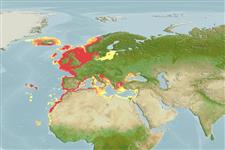Common names from other countries
Environment: milieu / climate zone / depth range / distribution range
Écologie
; profondeur 0 - 400 m (Ref. 78075), usually 15 - 50 m (Ref. 106788). Temperate, preferred 12°C (Ref. 107945); 68°N - 15°N, 32°W - 36°E (Ref. 113881)
Distribution
Pays | Zones FAO | Écosystèmes | Occurrences | Introductions
Eastern Atlantic and the Mediterranean Sea. Temperate to polar.
Length at first maturity / Taille / Poids / Âge
Maturity: Lm ? range ? - ? cm Max length : 11.0 cm SHL mâle / non sexé; (Ref. 78075); âge max. reporté: 8 années (Ref. 8702)
Max depth range from Ref. 113966.
Life cycle and mating behavior
Maturité | Reproduction | Frai | Œufs | Fécondité | Larves
Members of the class Bivalvia are mostly gonochoric, some are protandric hermaphrodites. Life cycle: Embryos develop into free-swimming trocophore larvae, succeeded by the bivalve veliger, resembling a miniature clam.
Demir, M. 2003. (Ref. 2754)
Statut dans la liste rouge de l'IUCN (Ref. 130435: Version 2024-1)
statut CITES (Ref. 108899)
Not Evaluated
Not Evaluated
Utilisations par l'homme
Pêcheries: commercial
FAO - Aquaculture: production; pêcheries: landings | FishSource | Sea Around Us
Outils
Sources Internet
Estimates based on models
Preferred temperature
(Ref.
115969): 7 - 15.9, mean 10.1 (based on 520 cells).
Résilience
Haut, temps minimum de doublement de population inférieur à 15 mois (K=0.51-1.34; tmax=8).
Prior r = 0.56, 95% CL = 0.37 - 0.84, Based on 1 data-limited stock assessment.
Vulnérabilité
Low to moderate vulnerability (25 of 100).
